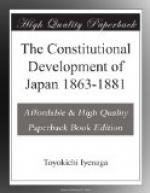[Footnote 3: This is also quoted in F.O. Adams’s History of Japan, Vol. I., p. 109. I have compared the passage with the original and quote here with some modifications in the translation.]
[Footnote 4: Jo-i means to expel the barbarians; Kai-Koku means to open the country.]
[Footnote 5: Given also in Kai-Koku Simatsu, p. 166; Ansei-Kiji, pp. 219, 220.]
[Footnote 6: Life of Ii Nawosuke Tokyo, 1888.]
[Footnote 7: Dickson’s Japan, p. 454.]
[Footnote 8: American Executive Document, Diplomatic Correspondence, Part 3, 1865-66, p. 233, 1st Sess. 39th Cong.]
[Footnote 9: American Executive Document, Diplomatic Correspondence, Part 3, 1864-65, p. 502, 2d Sess. 38th Cong.]
[Footnote 10: See Ansei-Kiji, pages 1, 3, 57, 59, 61, 174, 192, 352; Bosin-Simatsu, Vol. Ii., pp. 4, 69; Vol. III., pp. 379, 414; Vol. IV., pp. 121, 152.]
[Footnote 11: American Executive Document, Diplomatic Correspondence, Part 3, 1864-65, p. 486, 3d Sess. 38th Cong.]
[Footnote 12: Principles of Sociology, p. 540.]
CHAPTER II.
The restoration.
In the last chapter we have noticed what a commotion had been caused in Japan by the sudden advent of Commodore Perry, how the councils of Kuges and Daimios were called into spontaneous life by the dread of foreigners and by the sense of national weakness, and how the bombardments of Kagoshima and Shimonosheki tested these fears and taught the necessity of national union. I have remarked that free government is not necessarily the sole heritage of the Aryan race, but that the presence of foreigners, the change of the military form of society into the industrial form, the increase in importance of the individual in the community, are sure to breed a free and representative system of government.
In the following chapter we shall see the downfall of the Shogunate, the restoration of the imperial power to its pristine vigor, and the destruction of feudalism.
“The study of constitutional history is essentially a tracing of causes and consequences,” says Bishop Stubbs, “not the collection of a multitude of facts and views, but the piecing of links of a perfect chain.”
I shall therefore not dwell upon the details of the events which led to the downfall of the Shogunate, but immediately enter into an inquiry concerning the causes.
Three causes led to the final overthrow of the Shogunate:
I. The Revival of Learning. The last half of the eighteenth and the first half of the present century witnessed in Japan an unusual intellectual activity. The long peace and prosperity of the country under the rule of the Tokugawa dynasties had fostered in every way the growth of literature and art. The Shoguns, from policy or from taste, either to find a harmless vent for the restless spirit of the Samura




